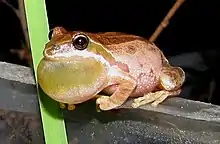Baja California chorus frog
The Baja California chorus frog (Pseudacris hypochondriaca) is a species of treefrog of Western North America.[1] It was formerly considered as part of the Pacific chorus frog (Pseudacris regilla), but was split and raised to species status in 2006. The species ranges from the West Coast of the United States from Baja California through southern California. Individuals live from sea level to more than 10,000 feet in many types of habitats, reproducing in aquatic settings. It occurs in shades of greens or browns and can change colors over periods of hours and weeks.
| Baja chorus frog | |
|---|---|
 | |
| Scientific classification | |
| Kingdom: | Animalia |
| Phylum: | Chordata |
| Class: | Amphibia |
| Order: | Anura |
| Family: | Hylidae |
| Genus: | Pseudacris |
| Species: | P. hypochondriaca |
| Binomial name | |
| Pseudacris hypochondriaca (Hallowell, 1854) | |
| Synonyms | |
|
Hyla scapularis var. hypochondriaca Hallowell, 1854 | |
Taxonomy
The naming of this frog has a very confusing history. These frogs have long been known as Pacific chorus frogs (Pseudacris regilla or Hyla regilla). Then, in 2006, Recuero et al. split that taxonomic concept into three species based on mitochondrial DNA comparisons.[2] Recuero et al. attached the name Pseudacris regilla to the northern species, renaming the central species the Sierran tree frog (Pseudacris sierra) and the southern piece the Baja California tree frog (Pseudacris hypochondriaca). Because the paper provided no maps or discussion of how to diagnose the species, it has been an extremely controversial taxonomic revision,[3] but has been incorporated into Amphibian Species of the World 6.0.[1] The taxonomic confusion introduced by this name change means that much of the information about Pseudacris hypochondriaca is attached to the name "Pseudacris regilla".
Cultural importance
Because this species of chorus frog is found near Hollywood, its vocalisations have frequently been used as stock sounds for film and television. As a result, its distinctive advertising call of "ribbit, ribbit" has become a standard representation of frog vocalisations, both in the United States and in the English-speaking world more widely, despite the fact that only it and a few closely related species actually make the sound.[4]
References
- Frost, Darrel R. (2015). "Pseudacris hypochondriaca (Hallowell, 1854)". Amphibian Species of the World: an Online Reference. Version 6.0. American Museum of Natural History. Retrieved 7 November 2015.
- Recuero, Ernesto; Martínez-Solano, Íñigo; Parra-Olea, Gabriela; García-París, Mario (2006). "Phylogeography of Pseudacris regilla (Anura: Hylidae) in western North America, with a proposal for a new taxonomic rearrangement" (PDF). Molecular Phylogenetics and Evolution. 39 (2): 293–304. doi:10.1016/j.ympev.2005.10.011. PMID 16627190.
- Dodd, C. K., Jr. 2013. Frogs of the United States and Canada. Volume 1. xxxi + 460.
- "Sounds of the Northern Pacific Treefrog". californiaherps.com. Retrieved 2018-01-08.